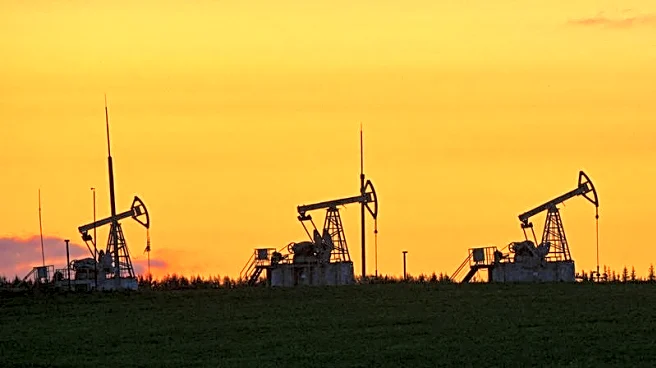What's Happening?
Oil prices remained largely flat early Thursday, following a decline to two-week lows in the previous session. The market is experiencing pressure due to weaker demand and a global oil glut. Brent crude
futures saw a slight increase of 2 cents, reaching $63.54 per barrel, while U.S. West Texas Intermediate futures remained unchanged at $59.60. According to J.P. Morgan, global oil demand has risen by 850,000 barrels per day year-to-date through November 4, which is below the previously projected growth of 900,000 barrels per day. The U.S. Energy Information Administration reported a rise in U.S. crude stocks by 5.2 million barrels last week, surpassing expectations of a 603,000-barrel increase. Capital Economics forecasts continued downward pressure on oil prices, predicting $60 per barrel by the end of 2025 and $50 per barrel by the end of 2026.
Why It's Important?
The current situation in the oil market has significant implications for global economic stability and energy policy. The persistent oversupply and weak demand could lead to prolonged low prices, affecting oil-producing countries and companies reliant on higher prices for profitability. This scenario may prompt oil producers to reconsider production levels and strategies to stabilize the market. Additionally, lower oil prices can impact investment in renewable energy and energy infrastructure, as cheaper oil may reduce the urgency for alternative energy sources. Consumers may benefit from lower fuel prices, but the broader economic impact could include reduced revenues for oil-dependent economies and potential job losses in the sector.
What's Next?
The oil market is likely to continue facing challenges as producers and policymakers navigate the balance between supply and demand. OPEC and its allies may need to reassess production targets to address the oversupply issue. Meanwhile, non-OPEC producers are expected to maintain or increase output, further complicating efforts to stabilize prices. Market analysts and stakeholders will closely monitor demand indicators, such as travel activity and container shipments, to gauge future trends. The ongoing situation may also influence energy policy decisions, with potential shifts towards more sustainable energy sources as part of long-term strategies.
Beyond the Headlines
The current oil market dynamics highlight the complex interplay between economic factors and energy policy. The oversupply and weak demand underscore the need for diversified energy strategies and investment in sustainable alternatives. This situation may accelerate discussions on energy transition and the role of fossil fuels in future energy systems. Additionally, geopolitical factors, such as production decisions by major oil-producing countries, could further influence market stability and global energy security.












